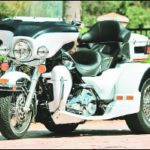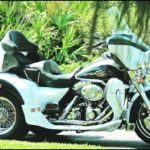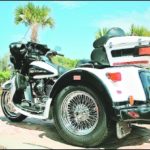Riding the wild learning curve
Getting schooled on three wheels in a big way
I knew the time would come when my professional growth and continued cultural relevance—what there is of it—would oblige me to get hip to the burgeoning trike phenomenon and get acquainted with the fundamentals and idiosyncrasies of three-wheeled motoring. It was inevitable. The demographic trajectory of the Baby Boom, that saw us soar to midlife affluence carrying the fortunes of the American motorcycle industry with us like a fanny pack, would inevitably reach a stage where gradual physical decrepitude, among other causes, would create a demand for three-wheeled alternatives in the motorcycle marketplace. And judging from the double-digit growth of the trike segment of the industry recently—even while other segments of the industry have stagnated and slipped—that time is nigh.
I could ignore it no longer, and even though I have some history of being an outspoken trikist (i.e., someone who discriminates strictly on the basis of a pair of car tires on what otherwise appears to be a motorcycle), I accepted my new duty stoically, and even warmed to the task figuring, hell, it might even be fun, and how hard could it be?
As it turns out, it is fun. And as it also turns out, there’s nothing easy about it—at least not at first.
The deep end
My introduction to serious triking came during Daytona Bike Week where I arranged for a couple of days aboard a Lehman Trikes Renegade conversion of an Electra Glide Ultra Classic. Might as well dive into the deep end of the pool, I figured, and learn my chops aboard a fully dressed, option-loaded, 1,200-pound gloat boat. To my advantage, I’ve logged a whole mess of miles on Harley’s Ultra Classic, so it was reassuring that the seating position, operational controls, switches and amenities on the Lehman were virtually identical to its two-wheeled OEM source. That, however, is where all similarity ends. Once the trike starts rolling, you’re in a totally foreign realm, one that owes little to either two-wheeled—or for that matter, four-wheeled—disciplines.
Simply put, you can’t learn to ride a trike proficiently without studiously ignoring most of what you’ve learned over the years about riding a motorcycle. You don’t want to unlearn those skills, since you’ll want to keep them available for later use, in all likelihood, but you must ignore them and ignore them immediately on a trike. That’s not easy to do since they tend to be hard-wired in your lizard brain, particularly the instinct to keep your feet on the ground when stopped. That’s an immediate revelation and a stubborn habit to break—especially if, like me, you’ve spent your adult life equating feet-up with keeling over like Arte Johnson. The second revelation was nearly as quick in coming to me, and it’s that the Lehman Renegade is one hell of a lot wider than an Ultra Classic, and when maneuvering in congested parking/p/pedestrian areas like you’ll find yourself in at most rallies (and in my case, it was the vendor area of the International Speedway) you need to be mindful of your wide-load status. This is educational, this new width-awareness, and is generally reinforced by the curses and threats of the bumped and bruised bystanders in your wake. So that’s two big new things we’ve learned and we haven’t gotten out of the parking lot.
Pumping iron
Once out of the parking lot, the revelations kept coming hard and fast, and the most persistent and recurring one is that it takes some burly upper-body strength to steer this thing. It’s true that riding a trike doesn’t demand much of your lower extremities, but if you’re considering going to three wheels because of weakness or disability down south, be aware that there’s a proportionate increase of demand on your upper extremities and start doing your push-ups. My first left turn off a stoplight at a busy intersection was downright harrowing. All my leaning instincts proved laughably ineffective at making the trike do anything, and it was only some determined straight-arming of the right grip that got the machine to heave over and around the bend without drifting wide and up over the curb. And I’m doing all of this while gassing it and feathering the clutch in first, and while the fat rear tires are taking turns being in charge.
It didn’t take me long to get adequately adept at the straight-arm turning drill, and a big part of the fun factor unique to trikes is that of whipping around a tight bend at a good clip and feeling like you’re truly getting sideways. I’m told that flipping a trike is a legitimate concern in those types of situations, but I pushed the envelope ever further with the Renegade as I got grooved to the procedure, and got nothing but bigger grins doing it.
It took a lot longer, however, for me to become accustomed to the weird sensations and quirks that come from those massive, willful rear tires. For one thing, they’re constantly in cahoots to overpower that skinny front tire, and they’re constantly at odds with each other in uneven and inconsistent pavement conditions. One thing’s for certain: You need to keep your hands on the bars and constantly course-correct the front end. It can be something as minor as the crown of the road causing a pronounced drift to the right, or something as major as what’s called “head shake” wherein the front tire and handlebars go into a shimmy akin to the first signs of an impending tankslapper in its efforts to translate the disparate inputs from the rear tires. But again, anticipating and adapting to these sorts of things become almost second nature with experience, and represent a substantial part of the trike learning curve. You just learn to take uneven situations as dead-on as possible; things like turning into a driveway through a gutter, or making a turn over asphalt swells in an intersection. When in doubt, go slow.
This is a lot to assimilate, and you need to assimilate it quickly. There is no graceful transition between two wheels and three; no twilight twixt day and night. Once you’ve made the jump, though, the rewards in terms of convenience and fun factor are just as quick in coming.
You come to realize, for example, that the feet-always-up protocol means no nuancing of brake timing and foot-planting when coming to a stop. Just hit the brakes, roll to a stop and sit there in your easy chair until it’s time to proceed. If you’re at one of those interminable stoplights like you find in pretty much every busy metropolis these days, just relax and have a snack; or a cigar; maybe check your e-mail. It’s nuts.
U-turns are nuts, too. Lock the steering and goose it. The Renegade spins donuts on demand. And out on the Interstate, all handling vagaries virtually vanish, and the Renegade is a mighty rock of stability in stiff crosswinds or truck wash. Just remember your wide-load status and motor down the center of the lane (another counterintuitive practice for the two-wheeled mindset). And bridge grating in bad weather? Forget about it. And the same goes for oil slicks, gravel patches, wet manhole covers and slippery tar snakes. This all takes some getting used to as well, as the years of practice at spotting these sorts of traction hazards are rendered meaningless—except to the degree that such hazards affect front end tracking, and even then there’s a sizeable cushion of correction time.
All the trimmings
As I noted early on, this Renegade came equipped with a number of Lehman options, and by far the most noteworthy of these was the transmission recently developed by Baker Drivetrain that incorporates a mechanical reverse gear into a standard 6-speed box. To put the Renegade in reverse, you step it into first gear and reach over to a toggle switch mounted on the right side of the fairing. That switch triggers a solenoid on the transmission allowing you to step the shifter down yet again into reverse. You hold the toggle down just long enough to do that and release it. Now you can back up the trike to your heart’s content, and when you’re ready to motor forward you simply shift back up into first, no solenoid action required. It’s a slick setup, and you get good at it with a few repetitions. And it beats hell out of the traditional reverse procedure on trikes which is you dismounting and putting your bad back and your bum knees into pushing the thing backwards. How that even gets done with a trike as heavy as this Renegade in situations like a nose-in, down-grade parking job at the curb mystifies me. But, then, there’s still a lot I don’t know about trikes and trikers.
Other options on this machine, things like mud flaps and a rear end light bar, are pure cosmetic flash, but this Renegade also has what Lehman calls the “Hawg EFX” which is a set of running boards filling the space between the rear fenders and the fairing lowers. These are eminently functional in offering additional foot placement, and thus riding postures, for the long miles, and that’s always welcome. A word of caution here, though: If you go with this option, it’s a good idea to remove the heel shifter from the machine. That’s because it’s oh-so-easy to start the trike up and let it warm to operating temp before mounting up, and it’s oh-so-easy to mount up using the running board as a mounting step. And if you’re inattentive you can inadvertently step on the heel shifter in the process. Not good.
What we’ve learned
Two days on three wheels is a fast ride up a long learning curve, and like anything else, the more I did it, the better I got, and I feel now at least marginally competent to jump on anything with three wheels and give it a decent spanking. I’ll be doing more of that, and when the heavily hyped Harley/Lehman collaboration on a Bar & Shield-badged trike finally bears fruit, I’ll be ready to put it through its paces and pass along my impressions. Until then, it’s back to two wheels for me. (Feet down, Terry! Feet down!)




















